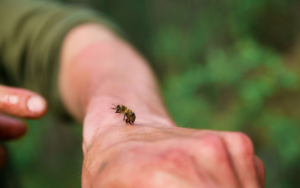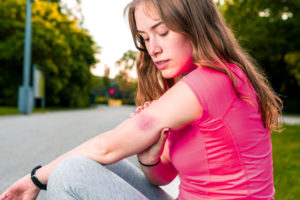So, you’ve been stung by a bee. Hopefully, your symptoms weren’t too painful! But are you wondering how bad the symptoms may be the next time you’re stung? It’s common to wonder whether you’ve experienced relatively typical bee sting symptoms and if it will continue to be the norm for you into the future. Should you be worried or relieved? Do your bee stings get worse each time?
Take some time to learn:
- Contributing factors to bee sting allergic reactions
- Which type of reaction you’ve had in the past
- What your past reactions might predict about your future encounters with bees
- How to move forward, prepared and confident
While it’s good to read up on this information, nothing takes the place of meeting with a medical provider. If you have questions or concerns, make sure to talk to a local specialist.
Factors to Consider When Wondering if Your Bee Stings Get Worse Each Time
While everyone responds to bee stings differently, there are a few main contributing factors to severe allergic reactions. Primarily, if you have a history of severe reactions, you must understand your risk for increased severity in the future. According to research, other factors may include older age, cardiovascular diseases, treatment with beta-blockers and ace inhibitors, and a rare disease called mastocytosis.
Additionally, fatalities associated with bee sting anaphylaxis are reported mainly in male adults.11
Bee sting allergies are serious
Understanding Your Past Bee Stings
Your history with bee stings is one of the best ways to estimate your future risk. Understanding whether you’ve experienced general symptoms or a local or systemic reaction is the first step.
General Symptoms
For those who aren’t allergic to insect stings, an altercation with a bee can still leave you in pain. Usually, a bee sting will cause discomfort, itching, and even burning at the sting site. These symptoms and any swelling will usually occur within a 2-3 centimeter diameter from the wound. Also, these symptoms could disappear after a few hours or even persist for a few days.
Large Local Reactions
A large local reaction can be defined as swelling at the site of the sting exceeding 10 centimeters.4 These symptoms may continue developing for up to a few hours after the incident. If the sting happened on your arms or legs, the symptoms could last for days or weeks while still being considered a local reaction. Consider taking over-the-counter medications to assist your recovery if your symptoms hinder your daily activities.
For the most part, large local reactions are not dangerous. However, if you are stung in or near your mouth/throat, watch very carefully for swelling.
If you have experienced an allergic, local reaction, your risk for a severe, systemic reaction is low: between 5 – 10%.4 But it is always best to consult with a local medical professional about your symptoms. Take notes or photos and schedule an appointment if you have any cause for concern.
Systemic Reactions
Systemic reactions can be divided into four categories, ranging from mild to life-threatening. All levels experience significant and persistent swelling. Then, symptoms usually escalate in the following manner:11
- Urticaria (hives, swelling within the upper skin)
- Angioedema (swelling of the lower layer of skin)
- Respiratory disorders (wheezing, difficulty breathing or talking)
- Anaphylactic shock (fall in blood pressure, unconsciousness, cardiac arrest)
Between 5 and 7.5% of Americans are hypersensitive to insect stings, with 60 deaths occurring each year from sting-related anaphylaxis.4, 2 Systemic reactions need to be taken very seriously! If you have had a severe bee sting reaction in the past, you are at a greater risk of another reaction of similar or increased severity. If you fall into one of the first two categories listed above, data suggests your risk is between 20 – 40% for a reaction of similar or increased severity with your next sting.11
If you experienced a reaction categorized by number 3 or 4, your risk for recurrence might be as high as 60%. This risk remains elevated for up to 20-years after your last systemic reaction.11

STEPS TO TAKE AFTER YOUR BEE STING
Most systemic reactions begin within 30 minutes after a sting. Typically, a reaction is more severe the sooner it begins to appear. For most people, systemic reactions then start subsiding within a few hours, but there is a small chance of relapse 6-11 hours later.11
Since bee stings can be so serious, and symptoms can appear differently, there are important steps you should take after being stung:
- Remove the stinger as soon as possible by scraping (pinching could release more venom)
- Pay close attention to your symptoms and, if possible, let someone nearby know what has happened
- If needed, apply first aid, administer epinephrine, or call 911
- If an allergy is suspected, follow up with a local medical professional for testing and treatment
Preventative (venom immunotherapy) and reactive (epinephrine pens) treatments are available for people with severe bee sting allergies. Find out what treatments can keep you safe and reduce your risk of a systemic allergic reaction.





